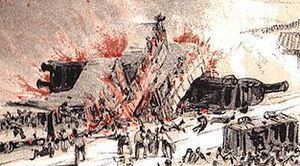Country France Date 8 May 1842 Trains 1 | Deaths 52–200 | |
 | ||
Similar Montparnasse derailment, Saint‑Michel‑de‑Maurienne derailment, Sonning Cutting railway a, Lagny‑Pomponne rail accident, Gare de Lyon rail accident | ||
The Versailles rail accident occurred on May 8, 1842 in the cutting between Meudon and Bellevue stations on the railway between Versailles and Paris, France. Following King Louis Philippe I's celebrations at the Palace of Versailles, a train returning to Paris derailed at Meudon, after the leading locomotive broke an axle, and the carriages behind piled into it and caught fire. The first French railway accident and the deadliest in the world at the time, it caused between 52 and 200 deaths including that of the explorer Jules Dumont d'Urville and his wife Adèle Dumont D'Urville. The accident led to the abandonment in France of the practice of locking passengers in their carriages.
Contents
Metal fatigue was poorly understood at the time and the accident is linked to the beginnings of systematic research into the problem.
Derailment and fire
By the late afternoon of Sunday May 8, 1842, the public celebrations being held in honour of king Louis Philippe I in the Gardens of Versailles had finished and many people wished to return to Paris. At 5:30 pm a train left the rive gauche Versailles railway station for Paris Montparnasse. Over 120 metres (390 ft) long and composed of 16 to 18 carriages hauled by two steam locomotives, the train was crowded, carrying 770 passengers. Travelling at 40 kilometres per hour (25 mph) between Bellevue and Meudon, one of the axles of the leading locomotive snapped and the vehicle derailed, scattering the contents of its fire-box. When the second locomotive and the carriages continued over the derailed locomotive, the carriages caught fire, trapping the passengers. The passengers were locked in their compartments as was the custom in continental Europe at the time.
The fire was so intense that the number of fatalities could not be determined, with estimates varying between 52 and 200, and hundreds of people were seriously injured. Among the deaths was the explorer Jules Dumont d'Urville and his family; his remains were identified by Dumontier, a doctor and a phrenologist, from casts he had made of the skull.
Some religious groups claimed that the passengers had been punished for travelling on a Sunday. A chapel named "Notre-Dame-des-Flammes" (English: Our Lady of the Flames) was built in Meudon in memory of the victims; this was listed as a Monument historique in 1938, but delisted in 1959 and demolished soon after.
Legacy
This was the worst rail disaster in the world at the time. The accident led to the abandonment of the practice of locking passengers in their carriages in France. The French government appointed a commission to investigate the accident; this recommended testing axles to determine their service life and monitoring their usage so that they could be replaced after travelling a safe distance.
Metal fatigue was poorly understood at the time and the accident is linked to the beginnings of systematic research into the problem. Work by Edwards, Rankine and others described the fatigue process and Rankine developed a solution for railway axles. Later, in 1856–1870, the work of August Wöhler would help to improve testing of axles, and so increase axle life.
